Tomorrow sees the two semi-finals of the 2024 Women’s Olympic Football tournament take place, with the United States taking on Germany for a place in Saturday’s Gold Medal contest after they defeated Japan and 2020 Olympic champions Canada, respectively, in the quarter-finals.
On the other side of the draw, Brazil — who knocked out host country France in the quarter-final — will need to overcome reigning World Cup champions Spain, who beat Colombia in a hard-fought contest that went to penalties for a place in the semi-finals.
This tactical analysis and player-focused Women’s Olympic Football scout report aims to preview the semi-finals while also providing some analysis of the tournament to date by going into detail on the performance of one key player from each of our Olympics 2024 semi-finalists.
We’ll analyse one player who’s proven vital to the tactics and results of each semi-final competitor, explaining what their opponents in tomorrow’s games will need to be keenly aware of as they prepare to battle for a spot in the final.
USWNT: Trinity Rodman
Starting with the US Women’s National Team, our key player is 22-year-old Trinity Rodman (173cm/5’8”) of the NWSL’s third-placed side, Washington Spirit — now managed by ex-Barcelona boss, Jonatan Giráldez.
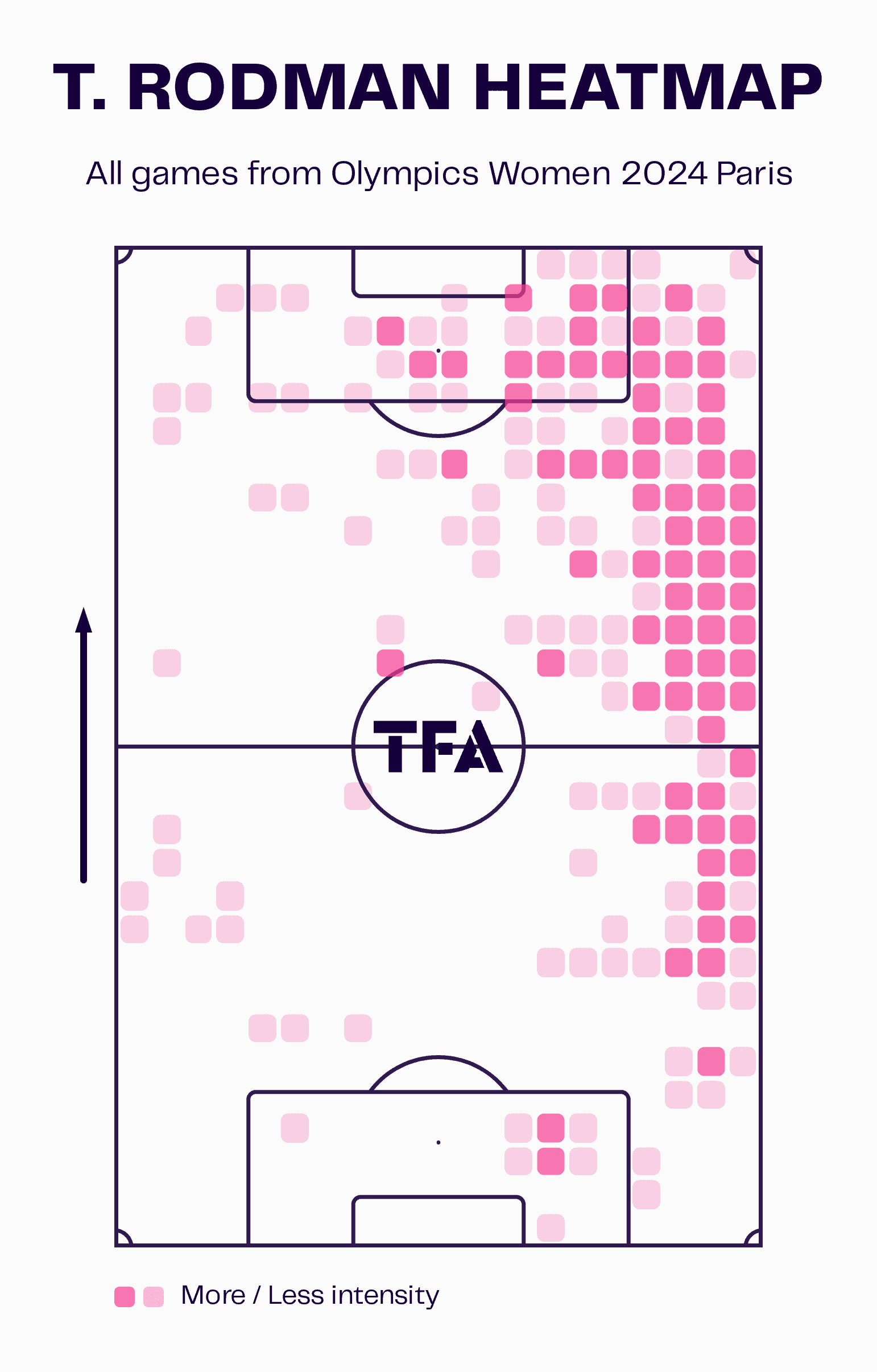
Rodman has featured in all of the USA’s games so far, playing the joint-most minutes of any attacker.
She has primarily featured for the USWNT on the right wing during this campaign, though she’s capable of providing an option on the left as well, which was explored for a brief period during this tournament, as the heatmap indicates.
She has gotten involved in the attack from fairly deep positions, not just within the final third, often picking the ball up closer to the halfway line.
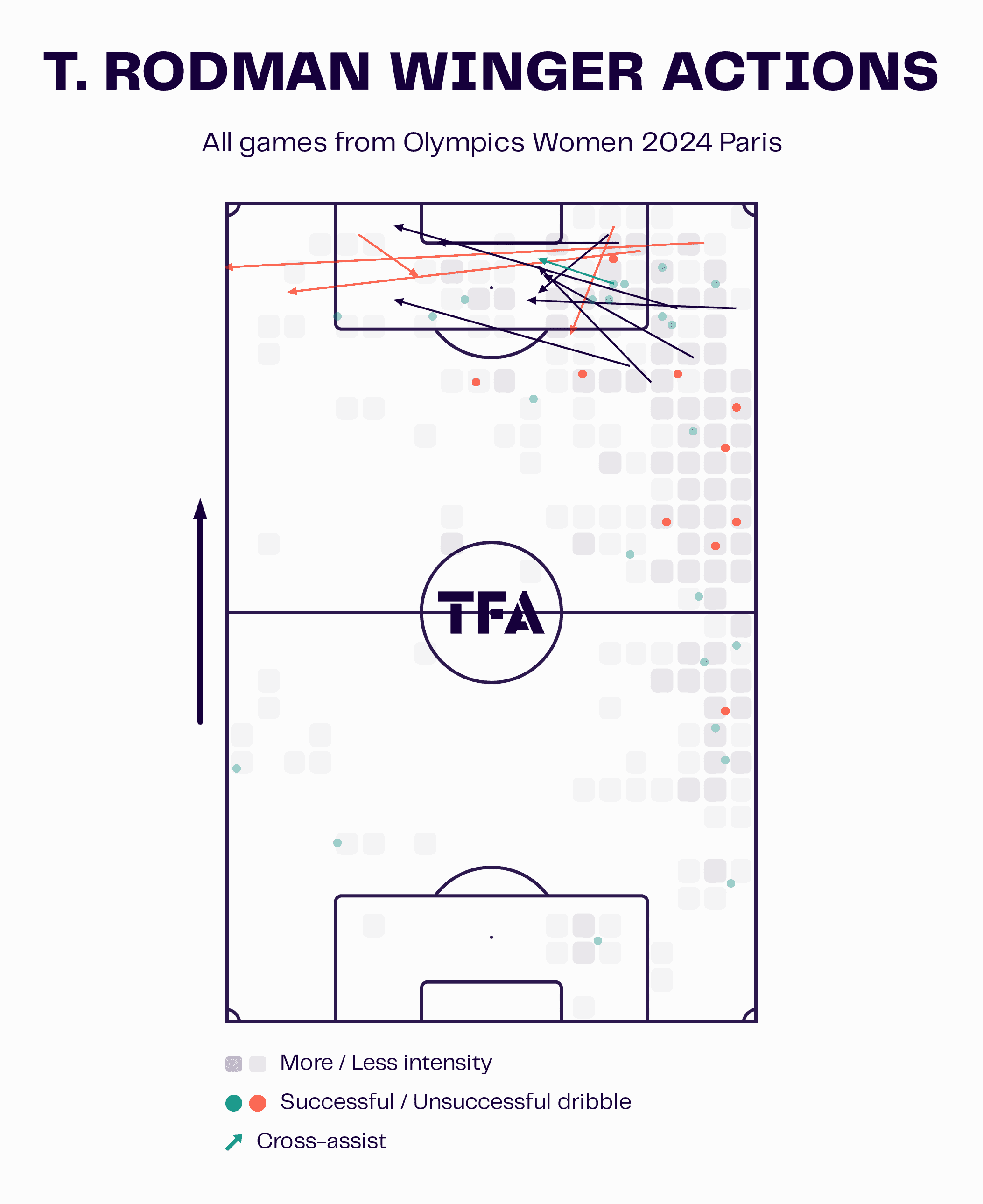
Moving on into figure 2, the heatmap fades slightly, giving way to a focus on Rodman’s dribbles and crosses in this tournament to date.
Here, we can see that while Rodman often gets involved outside the final third, she’s been at her most effective in it, with a lot more dribble success coming closer to the opposition’s penalty box and plenty of dangerous balls played into the opposition’s penalty area from the right inside the final third as well.
Indeed, Rodman comes alive inside the final third, when she can feel energised by the prospect of breaking the opposition’s last line of defence and creating something for her team.
This is where she’s been most valuable for the USA in this tournament, generating 0.91 expected assists so far, on top of completing the most dribbles (7.94 per 90) of any USWNT player during this competition with a decent success rate (69.7%).
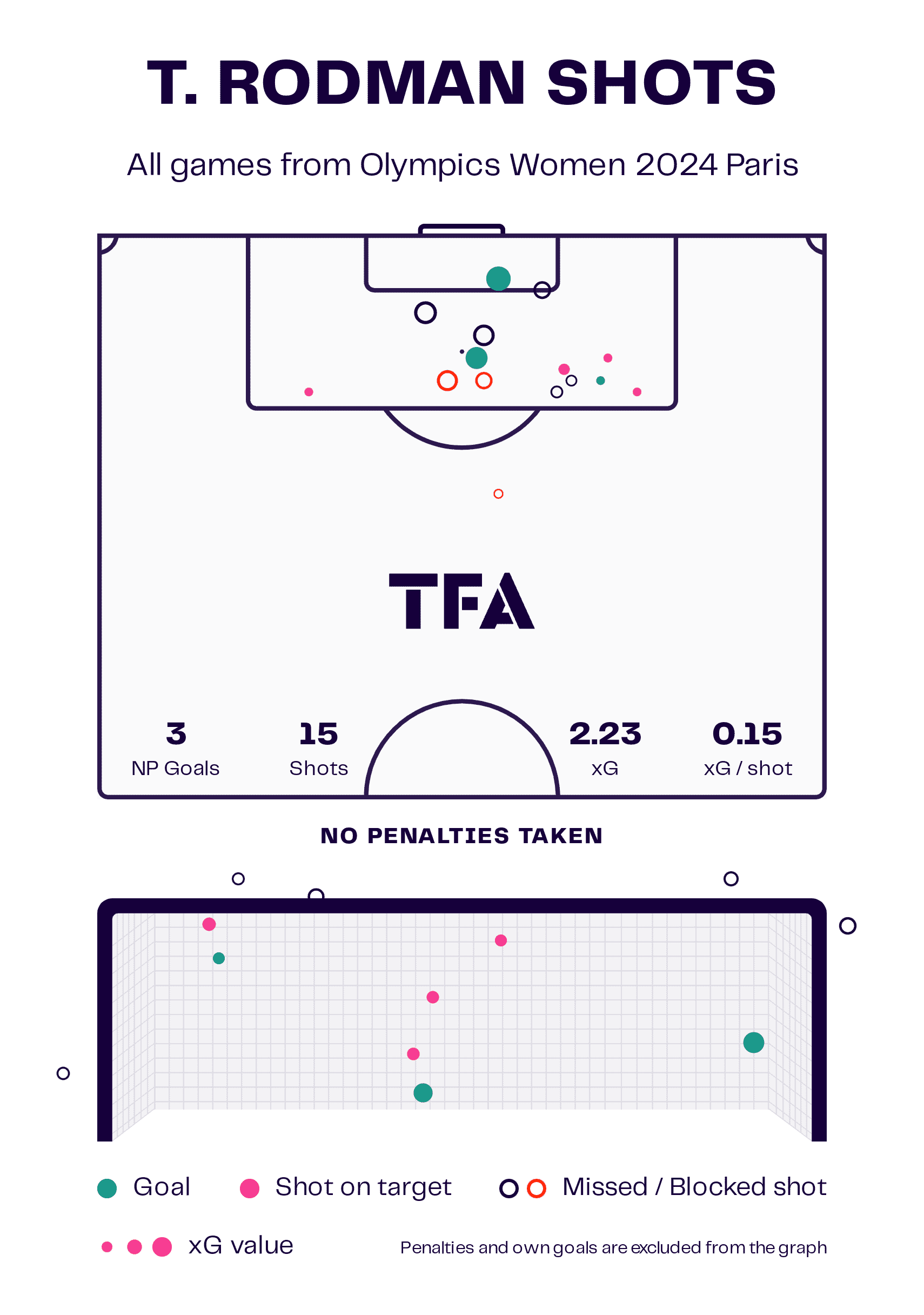
Rodman’s not just a chance creator, however, she’s also been a key goalscorer for the US at this Olympics, with her three non-penalty goals making her the country’s joint-top goalscorer with Mallory Swanson at the Olympics.
Rodman’s three goals have come from a total of 15 shots, which generated a solid xG of 2.23.
This equals 0.15 xG per shot—a decent number that reflects the Washington Spirit star’s decent off-the-ball movement and positioning inside the penalty box, which has allowed her to avail herself of several excellent goalscoring opportunities from high-percentage areas.
Germany WNT: Giulia Gwinn
The USA’s opponents in tomorrow’s earlier semi-final will be Germany WNT, and we’ve chosen to focus on FC Bayern’s 25-year-old Giulia Gwinn (171cm/5’7”) for our analysis.
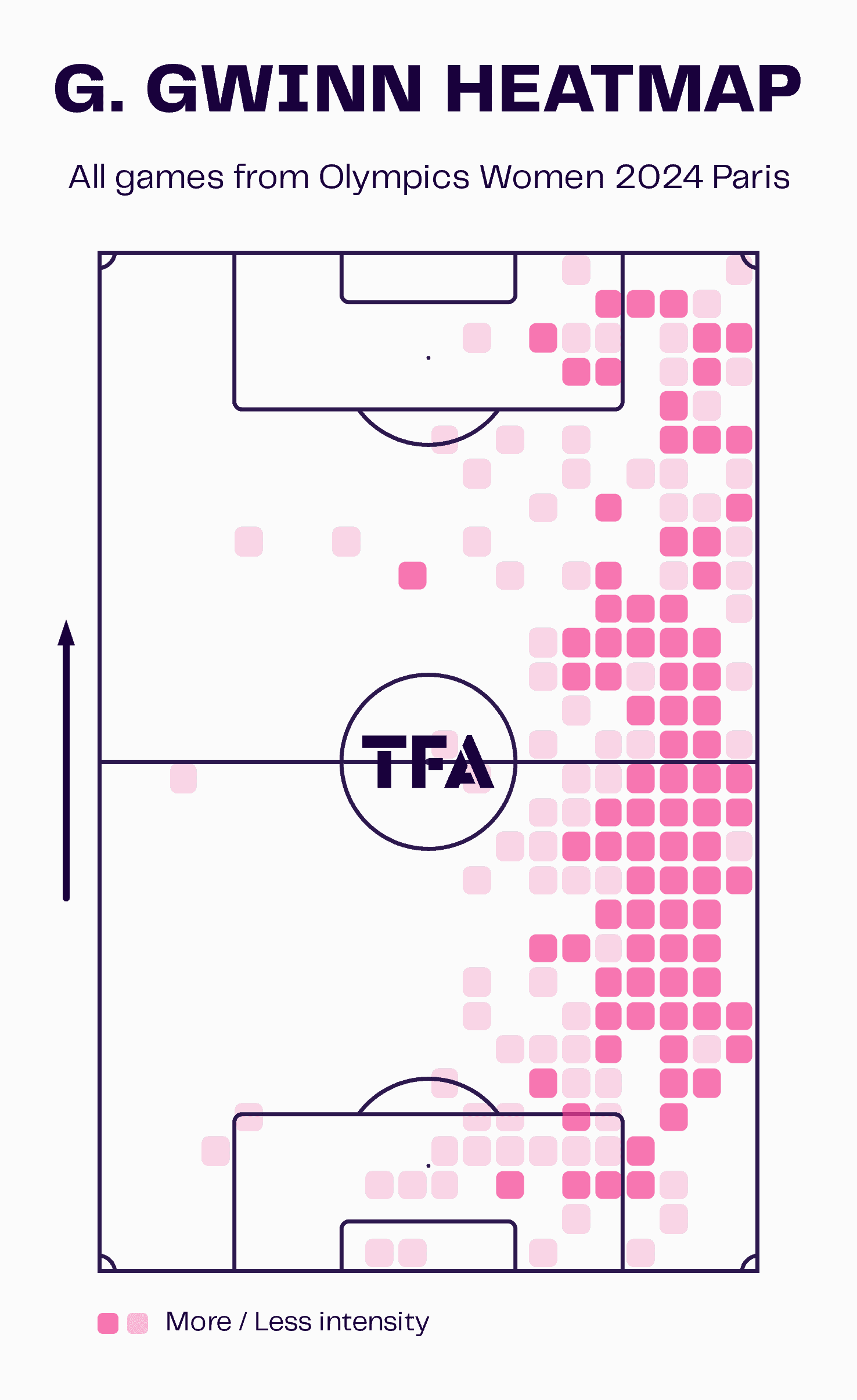
Starting with her heatmap, as we did for Rodman in the previous section, we can see that Gwinn has been involved far more in deeper areas and her own team’s half of the pitch than Rodman — this is due to her primarily playing as Germany’s right-back at the Olympics.
Still, she’s found ways to be incredibly impactful for her team both in and out of possession throughout the competition thus far.
Her impact has been felt in every moment of the competition to date.
Gwinn is the only Germany Women’s National Team outfield player to have featured in every minute of the Olympics thus far, and only goalkeeper Ann-Katrin Berger has shared the pitch with Gwinn for all 444 minutes of Germany’s journey to the semi-finals.
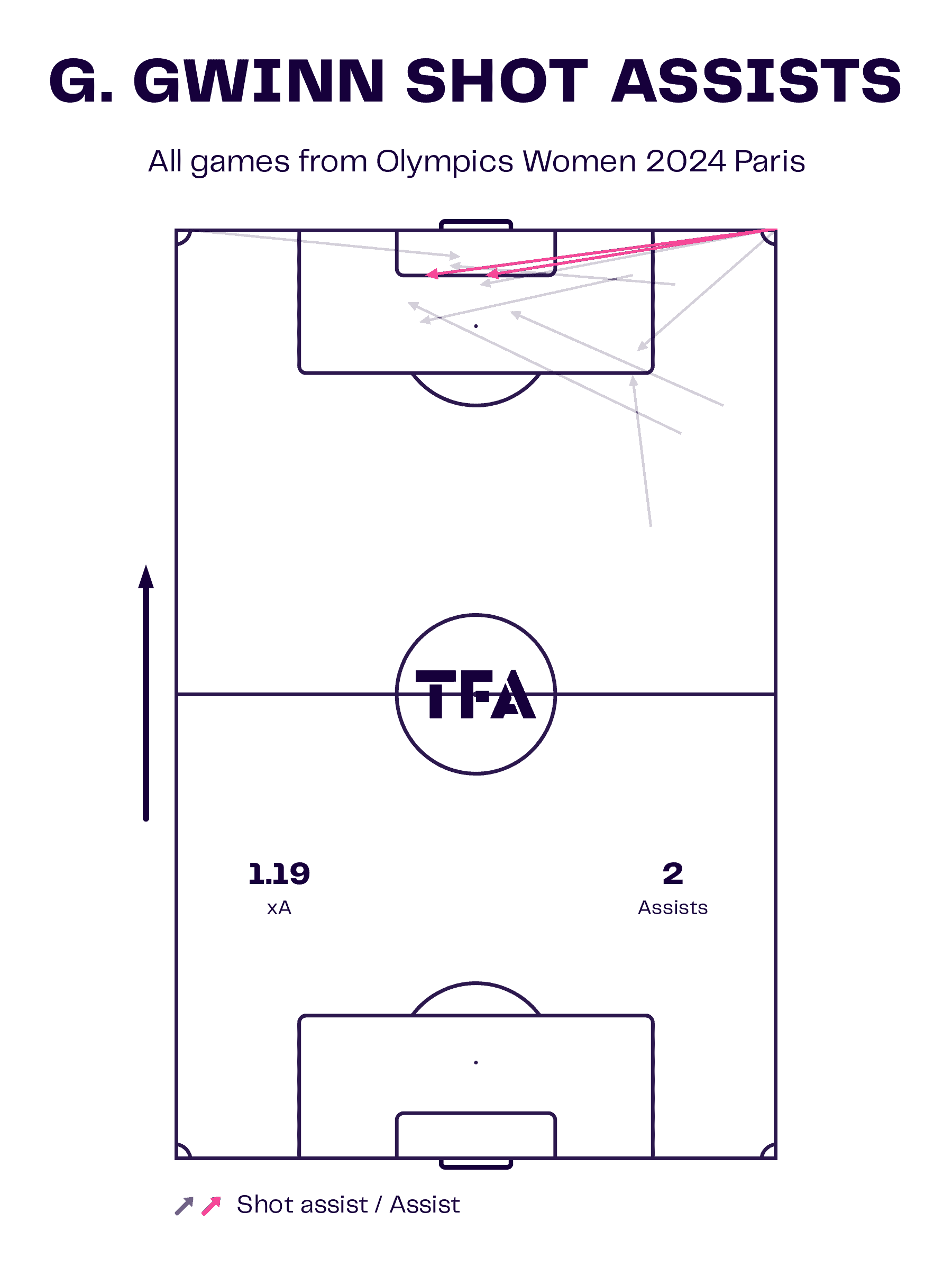
Gwinn’s crossing from the right has been an essential weapon for Germany at the Olympics, never more so than when she’s been delivering corner kicks into the danger zone.
Die Nationalelf scored more goals from corner kicks (three) than any other team during the group stage, and Gwinn has, thus far, made two goal assists from corners taken on her right side of the pitch, in addition to two more shot assists.
Unless the USWNT prepare well to defend against Germany’s well-orchestrated set-piece strategies, which include the use of the underloading principle and creation of orientation problems as our set-piece expert Karim El-shesheiny analysed in his piece titled: ‘2024 Olympics Women’s Football: Set Piece Analysis Of Final 8 Teams’ ahead of the quarter-finals.
Gwinn’s delivery has also been a key component of those successful set-pieces, and she’ll be looking to add to her tally of two assists thus far to help her team progress to the final.
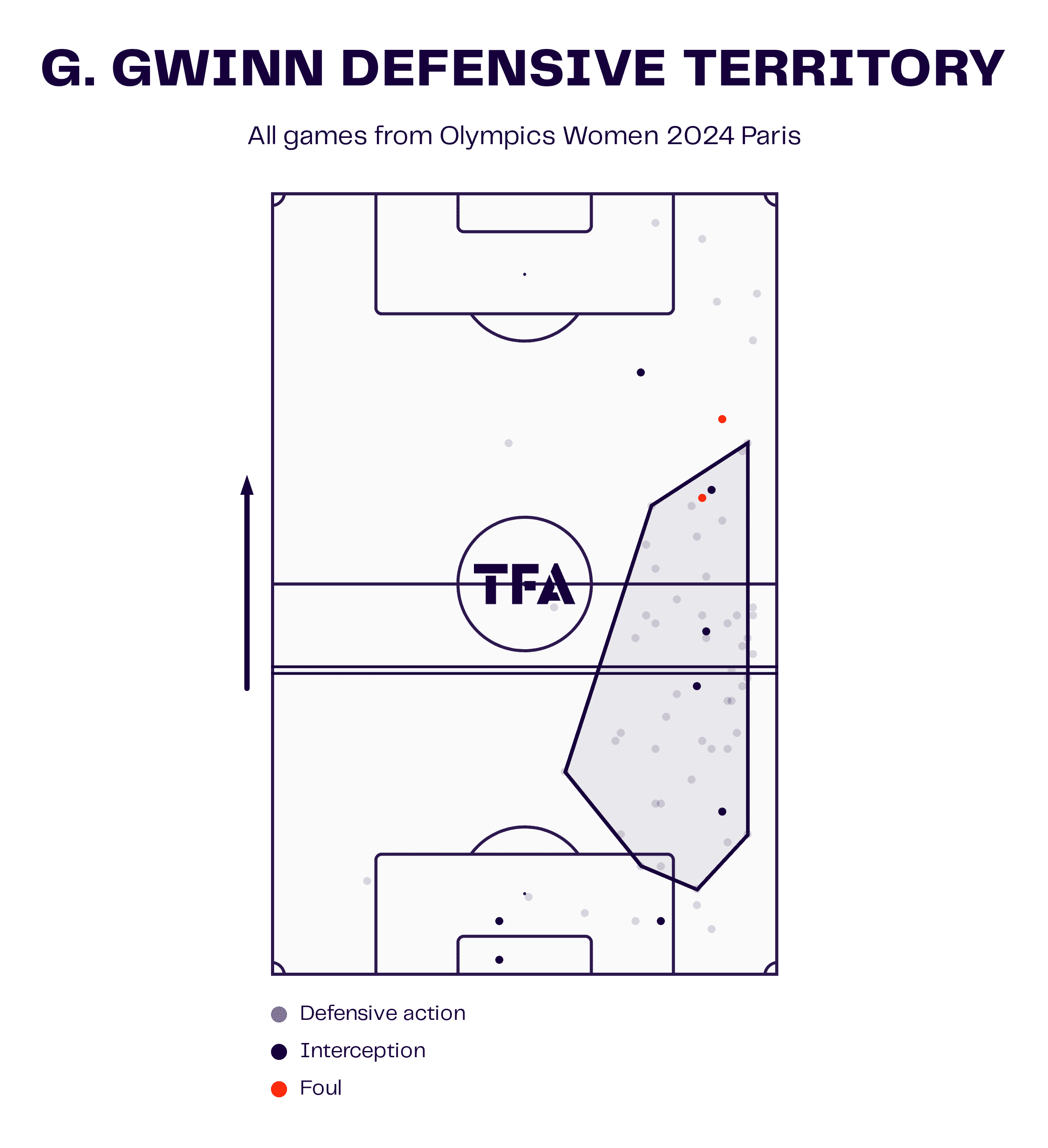
Of course, when analysing a right-back, we must consider her out-of-possession performance, too.
This is what leads us to figure 6 and Gwinn’s defensive territory map from the Olympics to date.
She has committed a couple of fouls, both of which occurred inside the opposition’s half and in fairly ‘safe’ zones to concede a free kick, while she’s got a clear smattering of grey dots inside her own half, representing her defensive duels.
Gwinn has engaged in 7.5 defensive duels per 90 this summer, emerging victorious from a solid 59.46% of them.
She has also made a solid 4.26 interceptions per 90, but it’s her defensive duels that have really stood out from an out-of-possession perspective.
These will make her a tough opponent for the USA’s left-winger—likely to be Mallory Swanson in the semi-final—creating a crucial battle in the game between the USWNT’s left-sided attacker and Germany’s right-sided defender.
Brazil WNT: Gabi Portilho
In our second semi-final, Brazil WNT and Corinthians winger/midfielder Gabi Portilho (165cm/5’5”) can be expected to play a key role for her side and features as our key player for the South American giants.
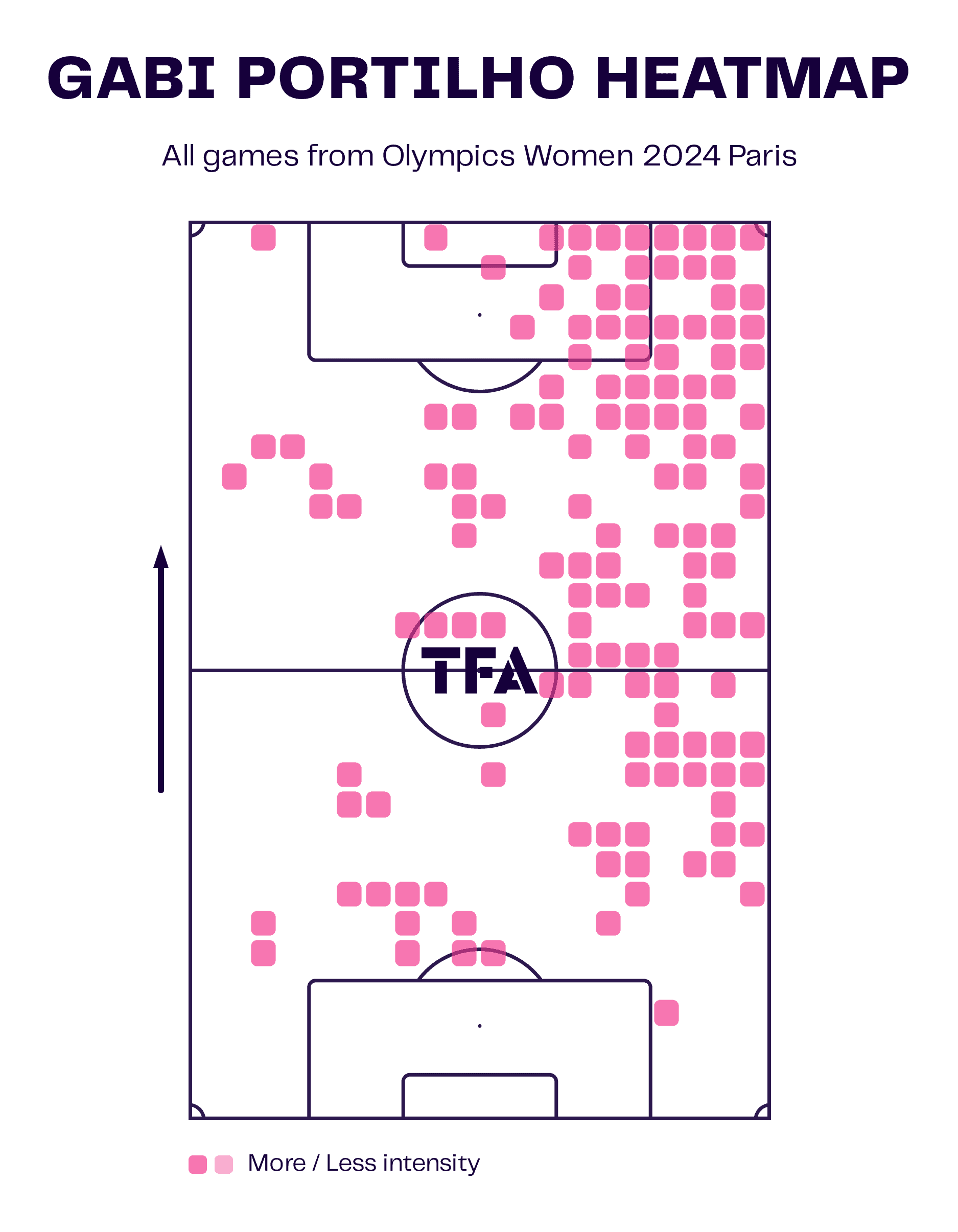
Portilho has accumulated the fewest minutes of any of our four ‘key players’ in this analysis in the tournament’s opening four games, featuring for just 275 minutes thus far.
Hence, the Brazil Women’s National Team star’s heatmap looks a little more scattered around.
Still, like Trinity Rodman for the USA, we can clearly see that she has primarily played as a right-winger for her national team this summer.
Rodman’s versatility has been explored more than that of Rodman or Gwinn from earlier, though, with the 29-year-old Brazilian also featuring in right central midfield, another role which can be made out from her heatmap in figure 7.
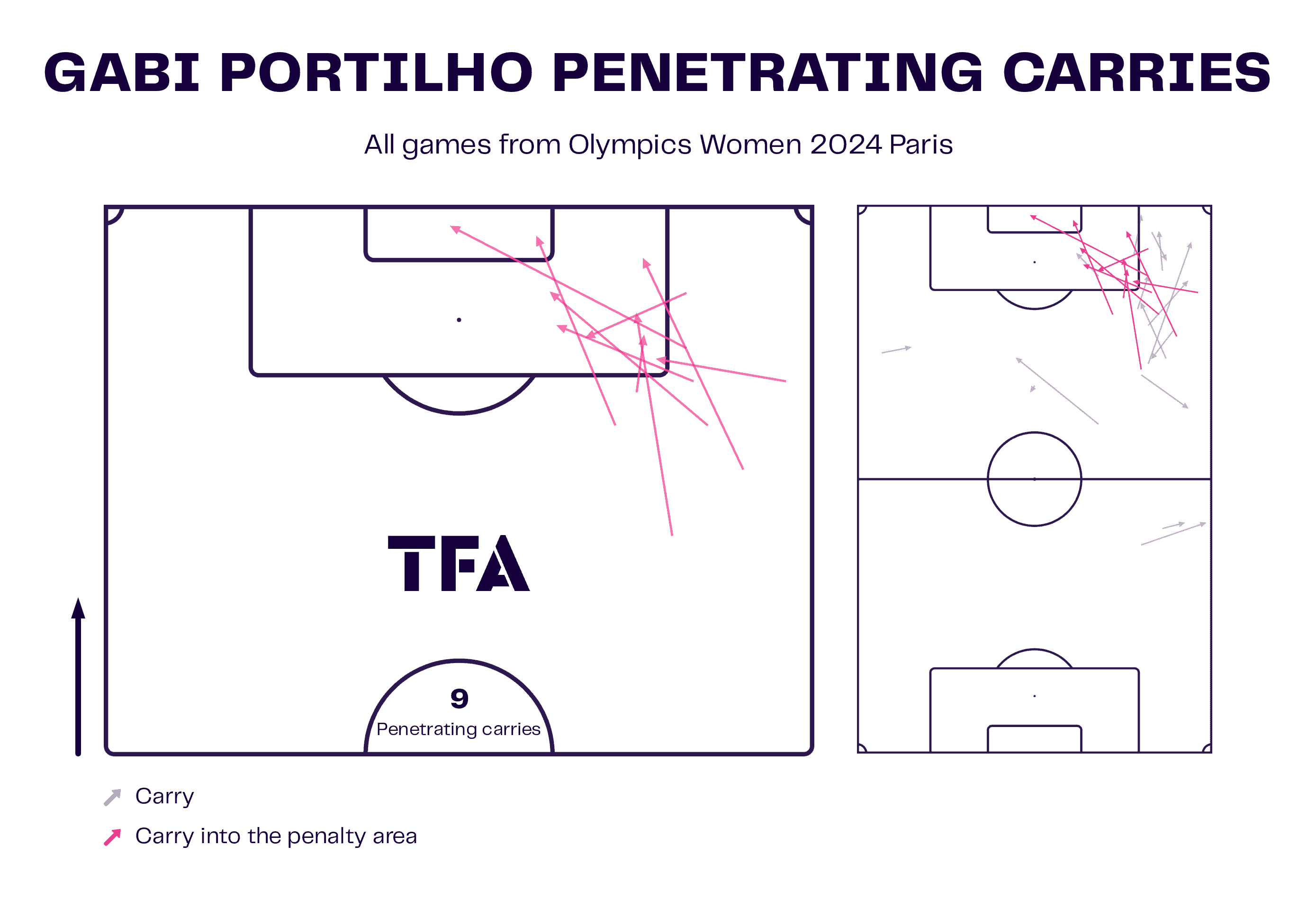
Portilho’s dribbling has been a vital aspect of her game at the Olympics this summer, with the Corinthians winger completing 7.85 dribbles per 90 for Brazil WNT — almost twice as many as second-placed Ludmila for that particular metric.
This dribble volume has seen her complete nine penetrating carries during her 275 minutes on the Olympic pitch this summer, which is not a poor tally by any means and showcases why we’ve chosen her as our key player for this analysis — she possesses a solid ability to break lines via her dribbling inside the final third, progress her team into dangerous positions and make something happen.
Portilho has provided a bit of a creative spark at times when Brazil have needed it this summer, and should they progress to the final, you’d be confident in the 29-year-old winger having played an important role in that success.
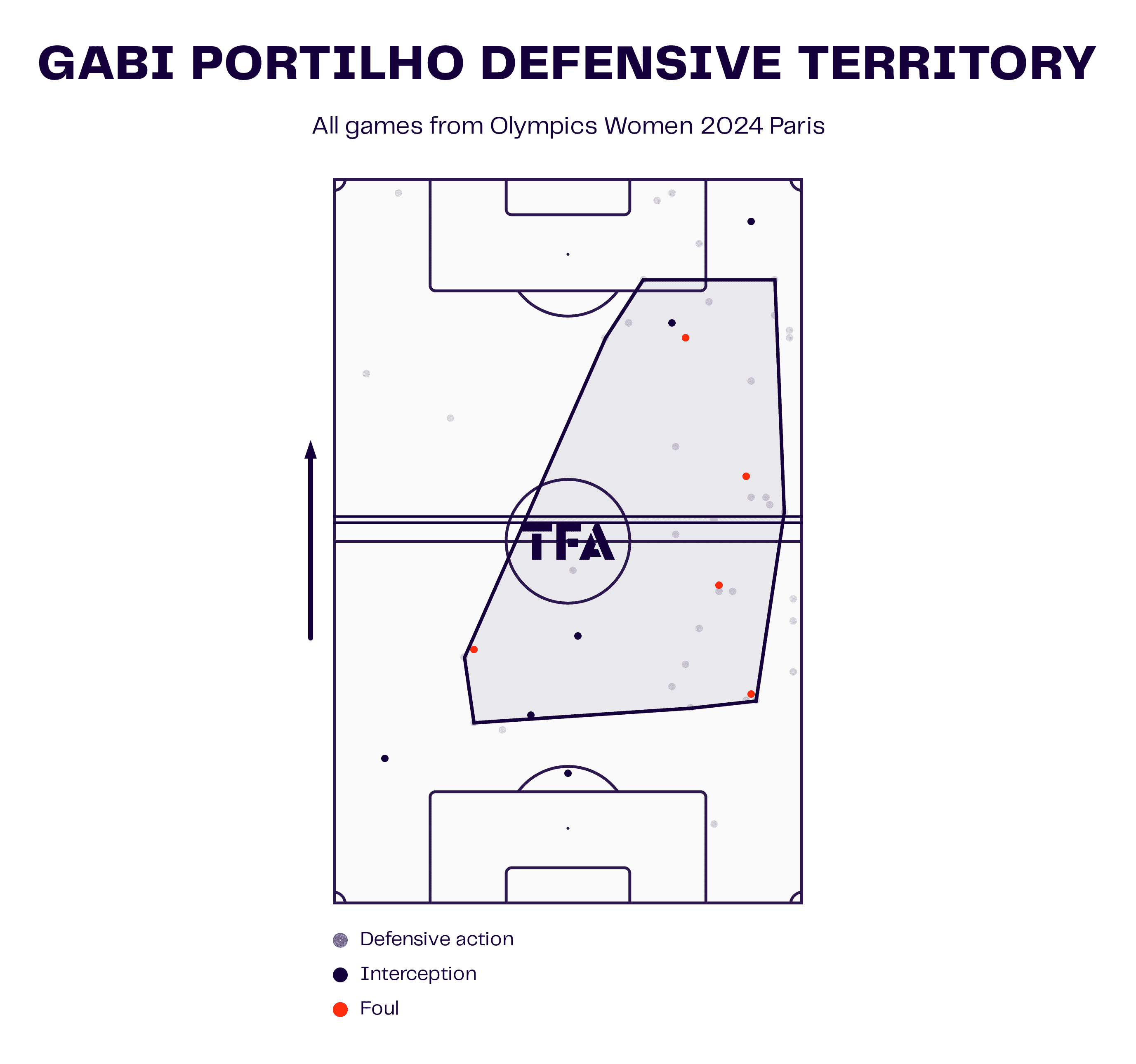
In addition to a few high regains, Portilho has been active in defensive phases and winning the ball back for her side in deeper positions, including deep inside her team’s own half of the pitch, as figure 9 shows.
In total, she has completed 10.15 defensive duels per 90 this Olympics — the second-most of any Brazil player — with a 64.52% success rate, highlighting her capabilities without the ball, which have been just as important as what she can do with it at times during the Olympics thus far.
A team player, expect Portilho to potentially pop up and have an impact in all phases of play in the semi-final against Spain.
Spain WNT: Mariona Caldentey
Our fourth and final player in this analysis — the one Brazil are going to have to concern themselves with stopping — is Mariona Caldentey (164cm/5’5”), who made her move from Barcelona to Barclays WSL side Arsenal this summer and is sure to be exciting Arsenal fans via her Olympic performances.
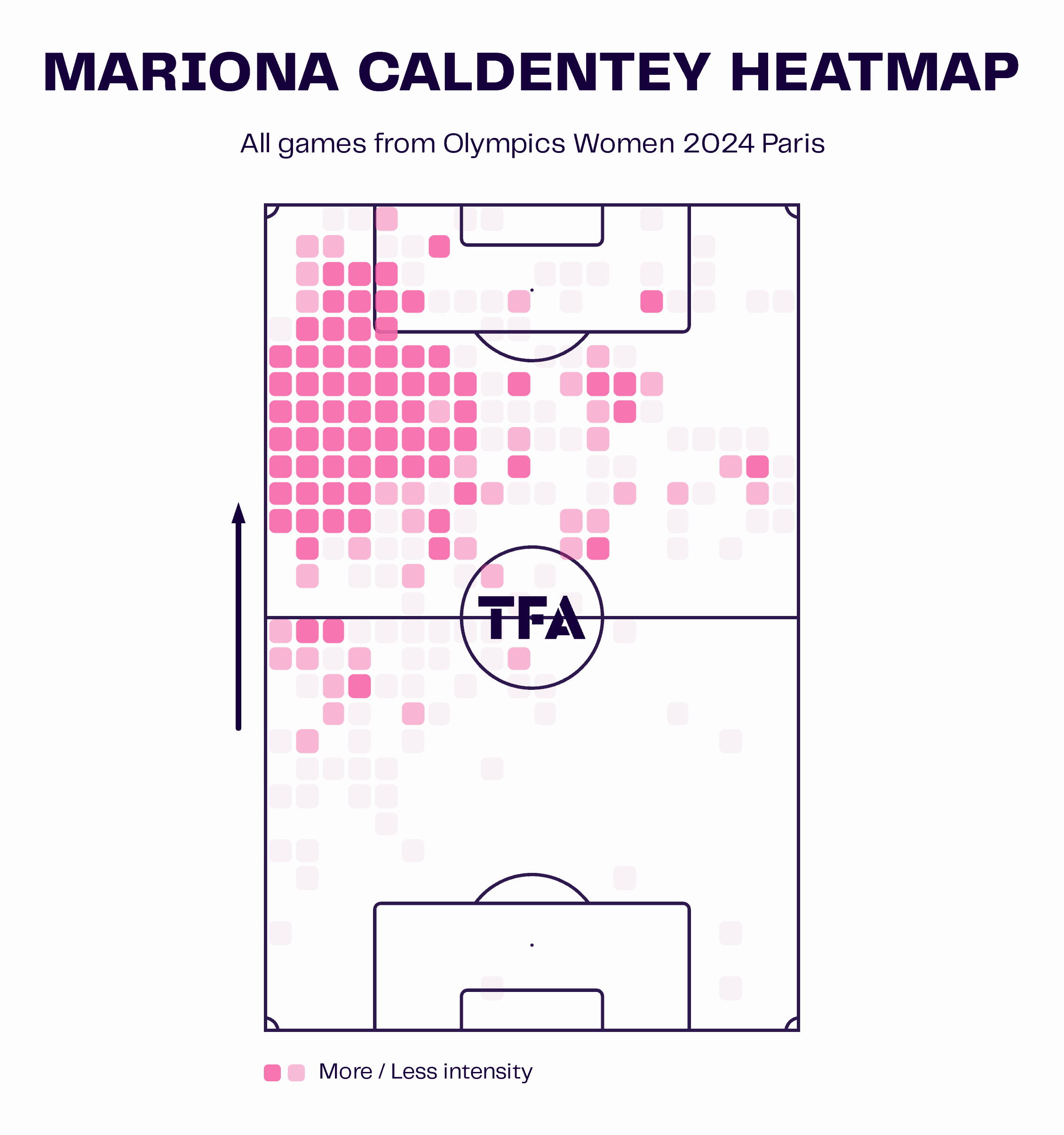
Firstly, take a look at Caldentey’s heatmap in figure 10 to see where she’s primarily been spending her time this tournament.
The new Arsenal player has been playing as a left-winger for Spain WNT, mainly getting involved in the left half-space just on the edge of the box, inside the final third — this is where we could say the 28-year-old playmaker is truly at home.
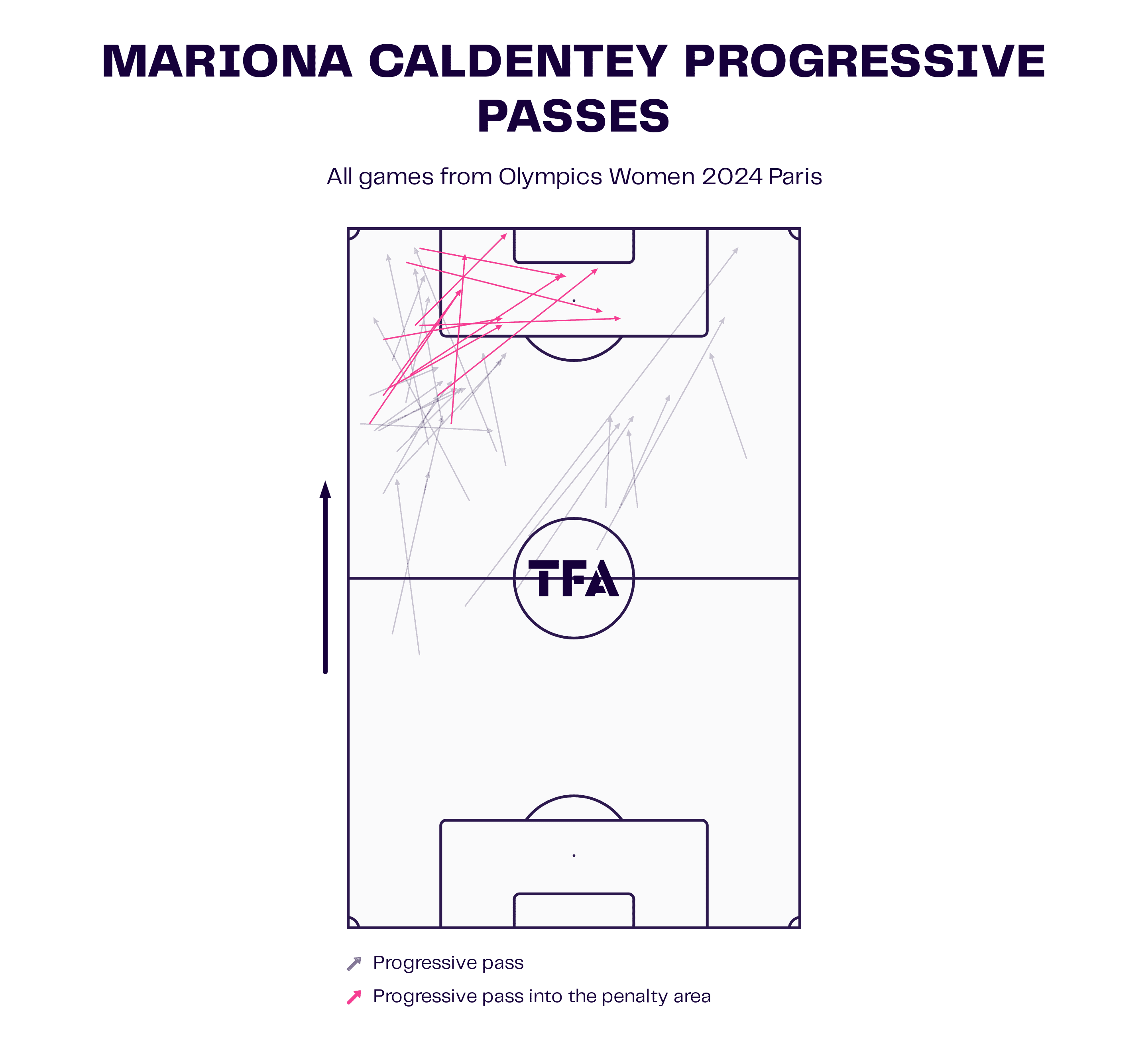
Caldentey’s total of 1.33 expected assists is the highest of any Spain player in the Olympics so far, but she still has zero actual assists.
Still, that’s not for the want of trying, as her expected assists numbers would suggest.
In fact, Caldentey has been highly active in putting the ball into dangerous positions for her attacking teammates this summer, as shown by her progressive pass map in figure 11, which features a lot of defence-splitting balls aimed from the left half-space and into the opposition’s penalty box, targeting positions from where her teammates could enjoy a fantastic goalscoring opportunity.
Caldentey has made an impressive 10.78 progressive passes this summer, completing 79.59% of them successfully.
On top of that, she has made the most key passes (0.88 per 90) and most smart passes (1.54 per 90) of any Spanish player.
The 28-year-old’s offensive impact has not just been in her passing, though; she has also been a key dribbler for her team, completing the most dribbles (6.38 per 90) of any Spanish player this summer.
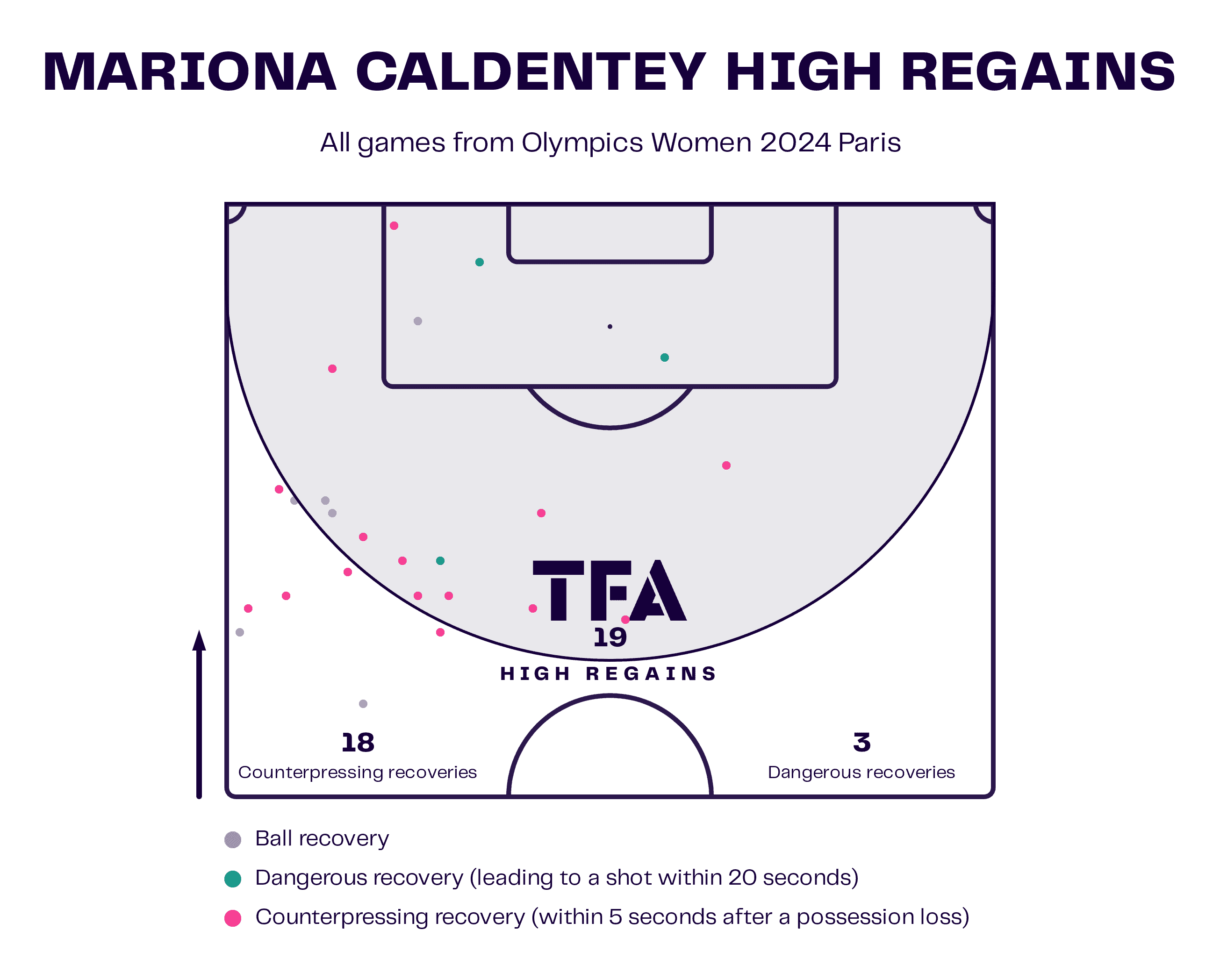
To add to the aforementioned attacking positives, Caldentey has also been highly active and effective for Spain Women’s National Team without the ball, notably in transitional defence, with her completing a whopping 18 counter-pressing recoveries and 19 high regains this summer—another weapon that could be used to create goalscoring chances for her team.
Conclusion
To conclude this Women’s Olympics tactical analysis and scout report, we’ve chosen the United States’ Trinity Rodman and Germany’s Giulia Gwinn as our two players to watch in the first semi-final, though several other players, including Gwinn’s likely direct opponent in that game, Mallory Swanson, are also well capable of having a huge influence on the outcome.
Rodman has been a driving creative threat and goalscorer for the USWNT this summer, and her semi-final performance could prove crucial for her side’s chances of progressing to the final.
Meanwhile, Gwinn has been highly impactful on and off the ball at the Olympics, especially via her set-piece delivery in possession and her quality in defensive duels out of it.
We’ve suggested keeping a close eye on Brazil’s Gabi Portilho and Spain’s Mariona Caldentey in the other semi-final, with both players vital to their respective team’s offensive and defensive performances.
Portilho has been Brazil’s most impactful dribbler in this tournament on the ball.
Off it, her defensive work rate and willingness to track back have proven very useful for her team.
Meanwhile, as for Caldentey, she has been immense across the board in offensive and creative metrics, while her contributions in defensive transitions have played an important part both in shutting down opposition counterattacks early and, again, generating goalscoring chances for her side.

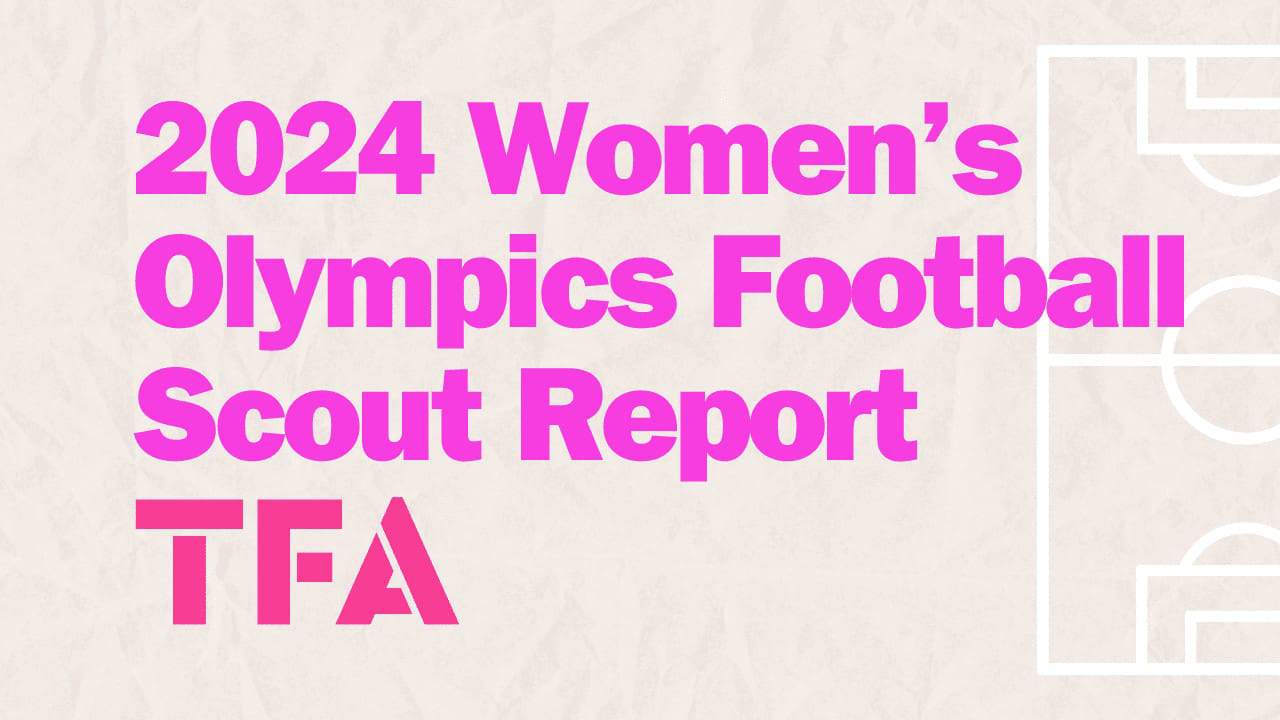



Comments